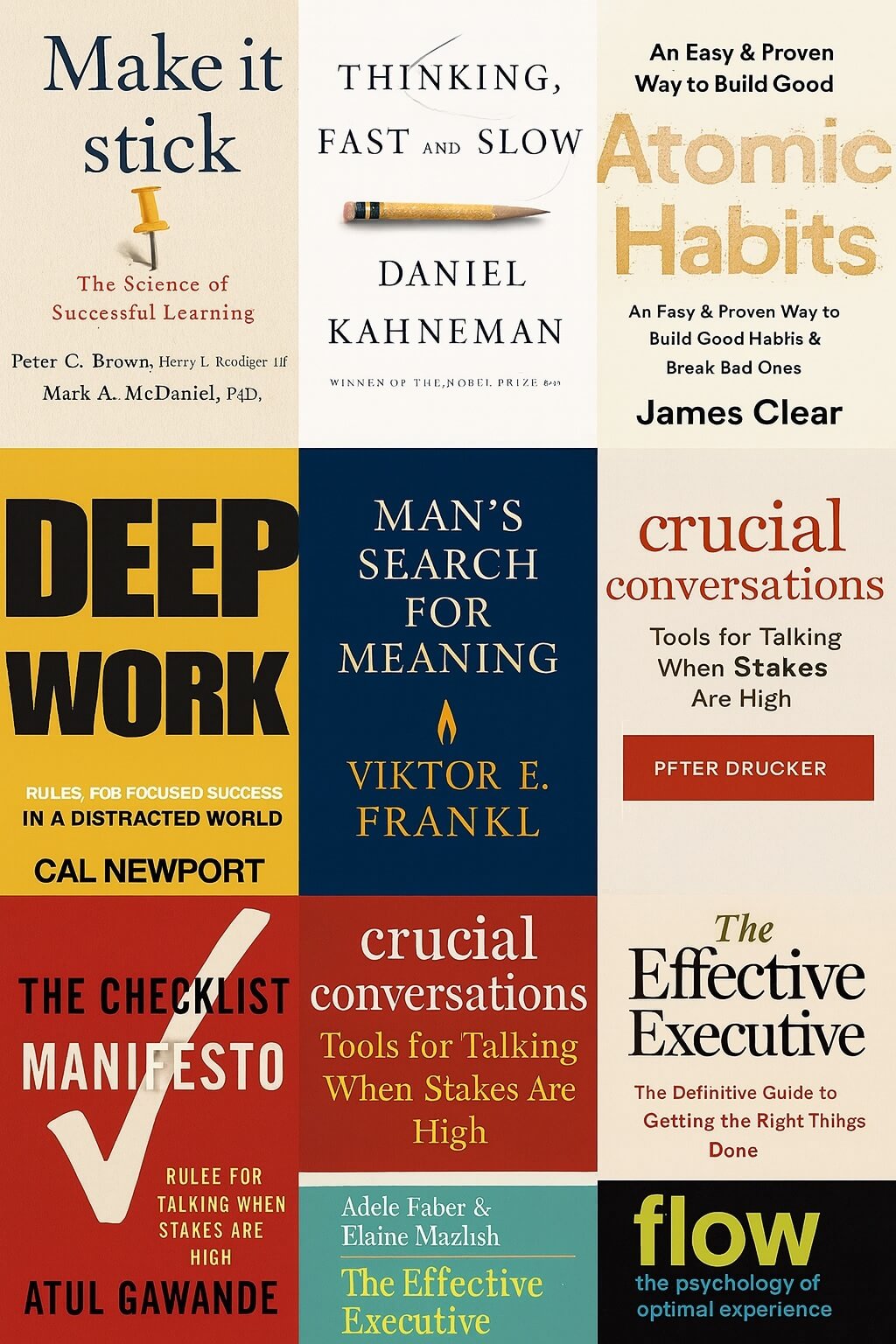
10 Books I Want to Read Every Year—And How They Shape Better Thinking, Work, and Life
Rereading a small set of books each year acts like scheduled maintenance for the mind. Concepts that felt abstract last year become practical this year because your life, work, and responsibilities changed. Key skills—questioning, memory, habits, focus, decision-making, communication, systems, leadership, meaning, and flow—get sharper with repeated exposure and deliberate practice.
Annual rereads support durable learning. Retrieval practice and spaced repetition outperform highlight-and-reread habits for long-term memory, so cycling through the same high-value books each year gives you built-in spacing and regular recall. A broad review shows testing, spacing, and interleaving sit at the top tier of learning strategies for lasting gains.
This list pairs each book with field-tested tactics and questioning prompts you can use the same week you read. You’ll also find brief evidence notes so the reading practice links to research, not superstition.
Table of Content
- 10 Books I Want to Read Every Year—And How They Shape Better Thinking, Work, and Life
- Overview
- Why Rereading the Same 10 Books Works
- The 10 Books (with week-ready tactics)
- Main Research Article Focus: Questioning Skills
- A Yearly Reading Plan You Can Keep
- Evidence Nuggets You Can Quote
- How to Read These 10 Books Actively
- Closing Thoughts
- FAQs
Overview
Learning science favors strategies that pull knowledge from memory rather than re-expose it. Retrieval practice, spacing, and interleaving show medium-to-large benefits across age groups and topics, with clear guidance for everyday study and professional training.
Attention research shows that interruptions raise stress and fragment work into brief “working spheres.” Knowledge workers switch often and need significant time to resume deep tasks, which supports structured focus blocks.
On the behavior side, habit research links repetition in stable contexts to automaticity over weeks, not days, and shows context cues and friction shape consistency.
Decision science documents reliable judgment errors under uncertainty, while checklists reduce avoidable mistakes in complex settings such as surgery.
Meaning and prosocial aims correlate with better health outcomes, and a widely cited cohort study links book reading with lower mortality risk in older adults.
Communication research supports empathy training and guided inquiry; self-explanation and elaborative interrogation help learners connect facts to prior knowledge.
Active learning raises exam scores and cuts failure rates in STEM courses, a reminder to replace passive reading with active prompts and practice.
Why Rereading the Same 10 Books Works
Memory mechanics that favor annual rereads
Spacing effect: revisiting content after time gaps yields stronger retention than massed review.
Retrieval practice: pulling ideas from memory (quizzes, prompts, teaching) cements learning better than re-reading.
Elaborative interrogation: asking “why/how could this be true?” links new info to prior knowledge and improves recall.
Questioning skills as the engine
Self-questioning and Socratic prompts expose gaps and surface assumptions; decades of work on self-explanation shows stronger understanding when learners generate their own explanations.
Focus matters
Knowledge workers spend about 11 minutes on a task before switching; interruptions speed people up yet increase stress. Deep, protected blocks counter this drift and create conditions for flow.
The 10 Books (with week-ready tactics)

1) Make It Stick — Peter C. Brown, Henry L. Roediger III, Mark A. McDaniel
Core idea: Make learning effortful through retrieval, spacing, interleaving, and varied practice.
Practice this week
-
End each reading session with a three-question recall in your own words.
-
Build a mini-quiz bank (index cards or notes) and test before re-reading.
Evidence link: A major review ranks practice testing and distributed practice as high-utility strategies across subjects and ages.
How to use it over a year
Quarterly pass: Q1 retrieval basics, Q2 spacing schedules, Q3 interleaving, Q4 mixed cumulative quizzes.
2) Thinking, Fast and Slow — Daniel Kahneman
Core idea: Two modes of thinking—fast heuristics and slow analysis—shape daily choices.
Practice this week
-
Pre-mortem: “If this fails in six months, why?”
-
Check base rates before forecasts.
-
Evidence link: Heuristics and biases (availability, representativeness, anchoring) and prospect theory are supported by decades of studies.
Questions to ask yourself
-
“What’s the outside view?”
-
“Which number did I anchor on?”
-
“What loss am I overweighting?”
3) Atomic Habits — James Clear
Core idea: Small, repeated actions in stable contexts compound into identity-level change.
Practice this week
-
Pick one keystone habit. Write a cue → tiny action → reward loop.
-
Reduce friction: place the book on your pillow, prepare the workspace, pre-commit to a two-page start.
Month-by-month
-
Months 1–2: install the cue.
-
Months 3–4: raise the step size.
-
Months 5–6: track “never miss twice.”
4) Deep Work — Cal Newport
Core idea: High-value output grows in long, undisturbed stretches.
Practice this week
-
Two 90-minute focus blocks with phone out of sight and notifications off.
-
One shutdown ritual to separate sessions.
Benchmarks
-
Daily: two blocks.
-
Weekly: one half-day focus sprint.
-
Quarterly: one offsite day for deep project planning.
5) Man’s Search for Meaning — Viktor E. Frankl
Core idea: Meaning, responsibility, and contribution help people face hardship.
Practice this week
-
Write a purpose statement in one sentence.
-
Pick one small act of service at work or home.
Reflection prompts
-
“Where do I add value that matters to others?”
-
“What principle am I willing to protect under pressure?”
6) The Checklist Manifesto — Atul Gawande
Core idea: Checklists turn complex, failure-prone tasks into safer, repeatable routines.
Practice this week
-
Build a pre-publish checklist for your writing process: claims checked, sources verified, quotes confirmed, alt text added, links tested.
Where checklists help
-
Hand-offs, deadlines, safety steps, legal or ethical review.
7) Crucial Conversations — Patterson, Grenny, McMillan, Switzler
Core idea: High-stakes conversations improve with clear intent, safety, and shared meaning.
Practice this week
-
Before a tough talk, write facts → story → feeling → request.
-
During the talk, mirror emotion, label it, and return to facts.
Pocket scripts
-
“Here’s what I see. Here’s the impact. What’s your view?”
-
“I may be missing something. Help me see your side.”
8) How to Talk So Kids Will Listen & Listen So Kids Will Talk — Adele
Faber, Elaine Mazlish
Core idea: Name feelings, describe problems, and invite solutions. Works with adults too.
Practice this week
-
Acknowledge first: “Sounds frustrating.”
-
Describe, don’t accuse: “The draft arrived without sources.”
Transfer to teams
-
Replace “Why didn’t you…?” with “What made X hard?”
-
Co-create next steps in plain language.
9) The Effective Executive — Peter Drucker
Core idea: Results flow from time, focus, and strengths.
Practice this week
-
Time audit for three days; drop or delegate low-value blocks.
-
One priority before noon, every day.
Research tie-ins
Active learning and deliberate practice outperform passive exposure. Treat your calendar as a learning lab: plan, do, review, adjust.
10) Flow: The Psychology of Optimal Experience — Mihaly Csikszentmihalyi
Core idea: Match challenge with skill and attention to experience absorption and enjoyment.
Practice this week
-
Pick one task you already like. Raise difficulty one notch, set a clear finish line, remove distractions.
Design cues
-
Clear goals, immediate feedback, tight feedback loops, fewer inputs.
Main Research Article Focus: Questioning Skills
Why “Questioning Skills” anchor this list
Questions drive retrieval, reflection, and behavior change. Three methods to keep near every book:
-
Elaborative interrogation - Ask “why/how could this be true?” for each claim. Results: better linkage to prior knowledge and higher recall across studies.
-
Self-explanation - Pause and explain the idea to yourself or a colleague. Classic experiments show sizable gains in understanding and problem solving.
-
Socratic prompts - Use short, open questions: clarity, evidence, viewpoint, implication. Guides from Richard Paul and Linda Elder offer practical taxonomies teachers and professionals use daily.
A Yearly Reading Plan You Can Keep
12-month cadence
-
Jan–Feb: Make It Stick → build recall/spacing habits.
-
Mar: Thinking, Fast and Slow → base rates, pre-mortems.
-
Apr: Atomic Habits → one keystone habit with cue redesign.
-
May: Deep Work → two daily focus blocks.
-
Jun: Man’s Search for Meaning → purpose statement refresh.
-
Jul: The Checklist Manifesto → process checklist for your craft.
-
Aug: Crucial Conversations → one real talk per week.
-
Sep: How to Talk So Kids Will Listen… → empathy scripts at home and work.
-
Oct: The Effective Executive → time audit and priorities reset.
-
Nov–Dec: Flow → redesign one project around clear goals and feedback.
Weekly template (repeatable)
-
One active read session (60–90 minutes).
-
One practice block (apply one tactic).
-
One reflection prompt (3–5 minutes).
-
One micro-share (teach one idea to a teammate).
Evidence Nuggets You Can Quote
-
Practice testing and distributed practice rank as high-utility learning strategies across topics and ages.
-
Spacing and interleaving boost durable retention across intervals and domains.
-
Self-explanation improves understanding in problem solving and text learning.
-
Elaborative interrogation (“why/how” questions) improves fact learning and comprehension.
-
Active learning raises exam performance and reduces failure rates in STEM courses.
-
Office workers spend about 11 minutes per task before switching; interruptions increase stress.
-
The WHO surgical checklist cut deaths and complications by roughly one-third in a multicenter study.
-
Purpose in life predicts lower mortality risk in large cohorts.
-
Reading books is linked to lower mortality risk and longer life in older adults.
-
Reappraisal (changing how you frame events) shows reliable effects on emotional outcomes across experiments and imaging studies.
-
Heuristics and biases are systematic; prospect theory explains loss aversion and reference dependence.
-
Habits often take weeks to months; median automaticity around 66 days in field data.
How to Read These 10 Books Actively
Before reading
-
Write three questions you want the book to answer.
-
Skim headings; predict three takeaways.
During reading
-
Pause every 10–15 pages. Summarize in one sentence.
-
Add a why/how question for any bold claim. ERIC
After reading
-
Teach one idea to a friend or online. This doubles as retrieval practice.
Closing Thoughts
A short yearly list builds depth. Read with questions, practice one small tactic each week, and track results in real tasks, not theory. The combination of rereading, questioning, and application is steady, simple, and hard to beat.
FAQs
1) How many books should I reread each year?
Ten works well for most people. That leaves space for new titles while protecting depth through repetition and application.
2) What if I can’t finish a book every month?
Split months into read weeks and practice weeks. Even one chapter plus a real-world experiment moves you forward.
3) Do audiobooks count?
Yes. Pause often to summarize aloud or jot a line. Add a short recall quiz at the end of each session to boost retention.
4) How do I pick replacements if one book stops helping?
Match a skill gap. For example: decision quality, habit design, attention control, communication under pressure, or purpose. Keep the questioning skills toolkit no matter the swap.
5) How do I measure progress without turning this into homework?
Use behavioral markers: number of recall cards reviewed, focus blocks completed, tough talks handled, checklists used, and one flow-designed project per quarter.
Must Read Books

